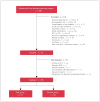Topical tranexamic acid in hip fractures: a randomized, placebo-controlled double-blinded study
- PMID: 34388107
- PMCID: PMC8519492
- DOI: 10.1503/cjs.014220
Topical tranexamic acid in hip fractures: a randomized, placebo-controlled double-blinded study
Abstract
Background: Tranexamic acid (TXA) has been shown to reduce perioperative blood loss in elective orthopedic surgery. The safety of intravenous TXA in nonelective hip fracture surgery is uncertain. The purpose of this study was to evaluate the efficacy and safety of topical TXA in hip fracture surgery.
Methods: Adult patients presenting to a community hospital with a hip fracture requiring surgery were randomly assigned to receive topical TXA or placebo. Hemoglobin and troponin I levels were measured preoperatively and on postoperative days 1, 2 and 3. All postoperative blood transfusions were recorded. Complications, including acute coronary syndrome (ACS), venous thromboembolism (VTE), cerebrovascular accidents (CVA), surgical site infections (SSI) and 90-day mortality, were recorded.
Results: Data were analyzed for 65 patients (31 in the TXA group, 34 in the control group). Hemogloblin level was significantly higher on postoperative days 1 and 2 in the TXA group than in the control group. The difference in hemoglobin level between the groups was not statistically significant by postoperative day 3. Significantly fewer units of packed red blood cells were transfused in the TXA group (2 units v. 8 units); however, 2 of the units in the control group were given intraoperatively, and when these were excluded the difference was not significant. The incidence of ACS, CVA, VTE, SSI, transfusion and all-cause mortality at 90 days did not differ significantly between the groups.
Conclusion: Topical TXA reduces early postoperative blood loss after hip fracture surgery without increased patient risk.
Trial registration: Clinicaltrials.gov, no. NCT02993341.
Contexte:: L’acide tranexamique (TXA) a permis de réduire les pertes sanguines périopératoires lors de chirurgies orthopédiques non urgentes. On ne connaît pas précisément l’innocuité du TXA lors de chirurgies urgentes pour fracture de la hanche. Cette étude avait pour but d’évaluer l’efficacité et l’innocuité du TXA topique lors de chirurgies pour fracture de la hanche.
Méthodes:: Des patients adultes ayant consulté dans un hôpital communautaire pour une fracture de la hanche nécessitant une chirurgie ont été assignés aléatoirement soit au TXA topique, soit à un placebo. Les taux d’hémoglobine et de troponine I ont été mesurés avant, puis 1, 2 et 3 jours après l’intervention. Toutes les transfusions sanguines ont été consignées, ainsi que les complications, telles que le syndrome coronarien aigu (SCA), la thromboembolie veineuse (TEV), l’accident vasculaire cérébral (AVC), l’infection de la plaie opératoire et la mortalité à 90 jours.
Résultats:: Les données ont été analysées pour 65 patients (31 dans le groupe sous TXA et 34 dans le groupe témoin). Le taux d’hémoglobine était significativement plus élevé aux jours postopératoires 1 et 2 dans le groupe sous TXA que dans le groupe témoin. La différence de taux d’hémoglobine entre les groupes n’était plus statistiquement significative au 3e jour postopératoire. Un nombre significativement moindre d’unités de culots globulaires ont été administrées dans le groupe TXA (2 unités c. 8 unités); par contre, 2 des unités dans le groupe témoin ont été administré pendant l’intervention, et lorsqu’elles ont été exclues, la différence n’était plus significative. L’incidence des SCA, des AVC, des TEV, des infections de plaies, des transfusions et de la mortalité de toute cause à 90 jours n’a pas été significativement différente entre les 2 groupes.
Conclusion:: Le TXA topique réduit les pertes sanguines durant la période postopératoire immédiate après la chirurgie pour fracture de la hanche, sans exposer les patients à un risque accru.
Numéro d’enregistrement de la recherche::
© 2021 CMA Joule Inc. or its licensors.
Conflict of interest statement
Competing interests: None declared.
Figures


References
-
- Canadian Institute for Health Information. Seniors and falls update sheet. CIHI National Trauma Registry. Ottawa: Canadian Institute for Health Information; 2010. Available: www.cihi.ca/CIHI-extportal/pdf/internet/SENIORS_FALLS_INFO_EN (accessed 2015 Jan. 31).
-
- Canadian Institute for Health Information. Hip and knee replacements in Canada: Canadian Joint Replacement Registry 2014 annual report. Ottawa: Canadian Institute for Health Information; 2014.
-
- Radcliff TA, Henderson WG, Stoner TJ, et al. . Patient risk factors, operative care, and outcomes among older community-dwelling male veterans with hip fracture. J Bone Joint Surg 2008;90:34–42. - PubMed
Publication types
MeSH terms
Substances
Associated data
LinkOut - more resources
Full Text Sources
Medical
